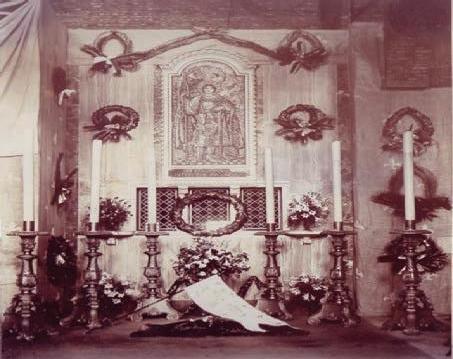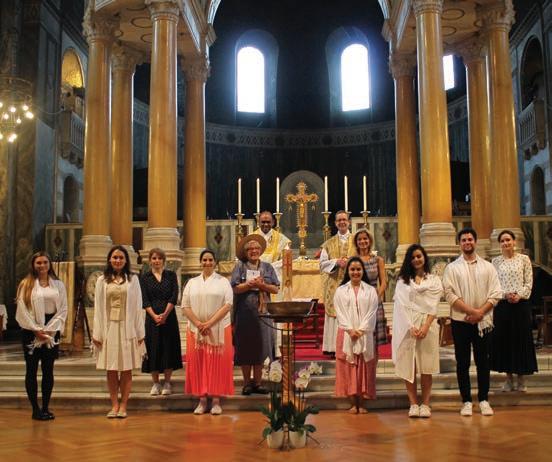
7 minute read
11
Cardinal Bourne’s Scrapbook
Fr John Scott
The spread of the Covid-19 pandemic and consequent reduction of Oremus magazine to a half-length online-only production for the months of May and June unfortunately prevented this piece from being published to mark the centenary of St Joan of Arc’s canonisation. However, another century cannot be left to pass before the record of the great Canonisation Pageant is looked at again.
On 16 May 1920 a great pageant took place in and around the Cathedral to celebrate the Canonisation of St Joan of Arc. This was widely reported and the Catholic Women’s League worked hard to gather as many images and newspaper reports of the event as they could, finally binding them all into a scrapbook which they presented to the Cardinal: ‘As a remembrance and a record and with [their] affectionate homage .. and a desire to carry out their Cardinal’s wishes, and with the help of the Cathedral Clergy to honour St Joan on the day of her Canonisation’.
It is no exaggeration to say that interest was nationwide, indeed if not also noted overseas. The names of a number of the papers are still familiar today – The Times, the Daily Telegraph, the Daily Mirror, Daily Mail and the Daily Express – whilst the Daily Sketch, Daily Chronicle and Morning Post have passed into oblivion. The Tablet and The Universe among religious papers are well represented in the scrapbook. In the rest of the country we find the Leeds Mercury, the Manchester Dispatch, the Sheffield Telegraph and the Birmingham Gazette, the Liverpool Courier and the Yorkshire Post. Across the Irish Sea, the Irish Independent reported, whilst north of the border the Glasgow Evening Times. Over the Channel we hear from L’Argus Soissonnais and La Justice, Havre and, from further afield, the Rand Daily Mail in Johannesburg.
The mosaic shrine, decorated for the occasion
The report of the Morning Post informs us that:
‘To mark yesterday’s canonisation of Joan of Arc as a saint of the Catholic Church, a solemn religious pageant in her honour was arranged by the Catholic Women’s League. It was a striking procession, and was witnessed by huge crowds in the immediate precincts of Westminster Cathedral. There was all the wealth of colour associated with celebrations of the kind, and those who participated in it displayed a religious fervour which vastly impressed the thousands of onlookers. Following contingents of Boy Scouts and Girl Guides there came many children from various schools. Nearly all the girls wore picturesque veils, as did their elder sisters who formed the contingents from numerous guilds. A figure representing the martyr’s triumph and the representation of St Joan of Arc on horseback, with attendant pages, were the outstanding features of the procession; but there was much interest in the French peasant children in dress of the period, in the French Embassy representatives, in the members of the French Red Cross, in the Brothers of the Little Oratory, the Ladies of Charity, the Catholic Suffrage Society, the Catholic nurses, several of them wearing the Mons medal, and the Catholic Police Guild, who brought up the rear.
Along the greater part of the route hymns were sung by the processionists. The Band of the Irish Guards, stationed outside the Cathedral, played whilst the procession was forming. On returning to the Cathedral there was a service at which Mgr Brown, Fr Smith and Fr Moore officiated, but so great was the crowd that an overflow service was held in the open-air, this being conducted by
St Joan of Arc, prepared for the procession

Mgr Howlett, Fr White and Fr Nartus. The temporary altar was crowned with laurel and draped with the English and French flags. Solemn Benediction concluded both services. The day’s celebrations were inaugurated by High Mass sung by Bishop Butt.’ Rather more excitedly, the Daily Express’s headline reads:
‘Mystery Maid in Armour. Who was the St Joan of Yesterday?
Twenty thousand people followed the beautiful Maid of Orleans who rode in the canonisation procession yesterday through the streets surrounding Westminster Cathedral – and none knew who she was who took the honoured place. More than 40,000 watched the maid, clad in armour on a white charger, go by, and all of them asked that question eagerly of each other. Mystery enwraps the young girl, not more than 17 years of age, who carried the actual sword and shield borne by St Joan in battle and rusted with the blood of former English foes. It was whispered that the figure in shining armour, with the cropped hair and steadfast eyes of Joan of Domremy, was a descendant of a martyr who died for his faith on Tyburn Tree.’ In calmer mood the Daily Telegraph reported that:
‘St Joan was impersonated by a beautiful girl of 17, a member of a well-known [but not to readers of the Daily Express – Ed.] Catholic family, the head of which is prominent in the legal world. She rode a grey horse, and wore a suit of armour lent by Mrs H B Irving. She carried a standard specially sent from France.’ The Daily Mail, however, felt it necessary to comment further: ‘With the late afternoon sun playing on her short, dark brown hair and glinting on her armour, she attracted all eyes’, whilst the National News noted that the standard carried was the gift of the Comtesse de Montholon.
The Daily Chronicle’s account goes into some detail about the suit of armour, the horse’s caparison and St Joan’s six pages: ‘the two most striking were a shapely youth in a brilliant orange-coloured puffed jacket, and another in a dark green velvet cloak’. But it then goes on to quote from one of the hymns sung in the procession, in which the recent slaughter of the Great War raises its head. Under the heading Amende Honorable these verses are printed: ‘Though our fathers once reviled thee, Wreaked on thee a bitter spite, Lo! their children live to hail thee Saint and Virgin, Heaven’s Knight! See the land thou loved’st so dearly Scattered with our country’s dead; We have paid the debt we owed thee, In thy cause our youth has bled. For they left their hills and valleys, Left the gladder things of life, Toiled and fought from Rheims to Rouen, Held them nobly in the strife.‘ The Universe reported that:
‘Hawkers sold, at profiteering prices, unauthorised and incomplete programmes. The official programme sellers were inadequately stocked and not sufficiently numerous, but the size of the phenomenal crowd could hardly have been anticipated. When all was ready for the coming of the procession, men of the Blessed Sacrament Guild came along with indicators bearing such legends as ”All Sing” and ”Singing to Cease”. They took up positions at various points. Some of them were afterwards seen in company with conflicting banners. Confusion resulted. The singing was not, on the whole, the most brilliant feature of the event. At one point stationary bands within earshot of each other were at variance. It was a pity that the specially-written hymns were not sung with more unison.’ However, there is no doubt as to the success of the pageant. The Universe’s headline reads: ‘Scenes at Westminster Reminiscent of the Historic Congress’ and the report comments that: ‘The crowd exercised wonderful restraint in its reception of the devotional representation. There was no cheering, though the emotional tension was very great’.
The last word must be left with Fr Bampton SJ, who preached at the outdoor service. He claimed that time had brought its revenge. The crime was not alone that of the English nation and its accomplices. The Church was implicated in it through the action of time-serving prelates like the Bishop of Winchester and the Bishop of Beauvais. But Catholics were not concerned to defend them; they claimed no immunity in such circumstances for the Church’s ministers. The Church owed it to herself to reverse the verdict, and the Canonisation of the Maid was a triumphant reversal: her character was henceforth transfigured with a halo of sanctity. ‘We Catholics, descendants of those men who soiled the name of Catholicity by this foul crime, are assembled here to repudiate it and to thank God that this injustice has been undone.’
The procession passes along Ambrosden Avenue – note the men all wearing hats











